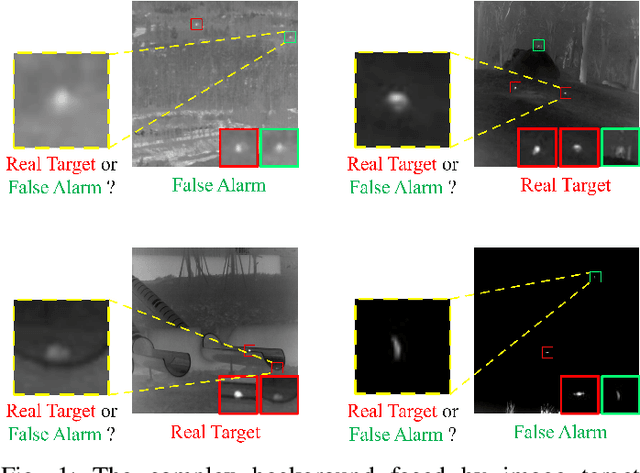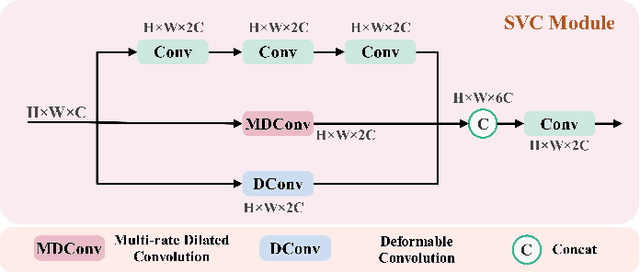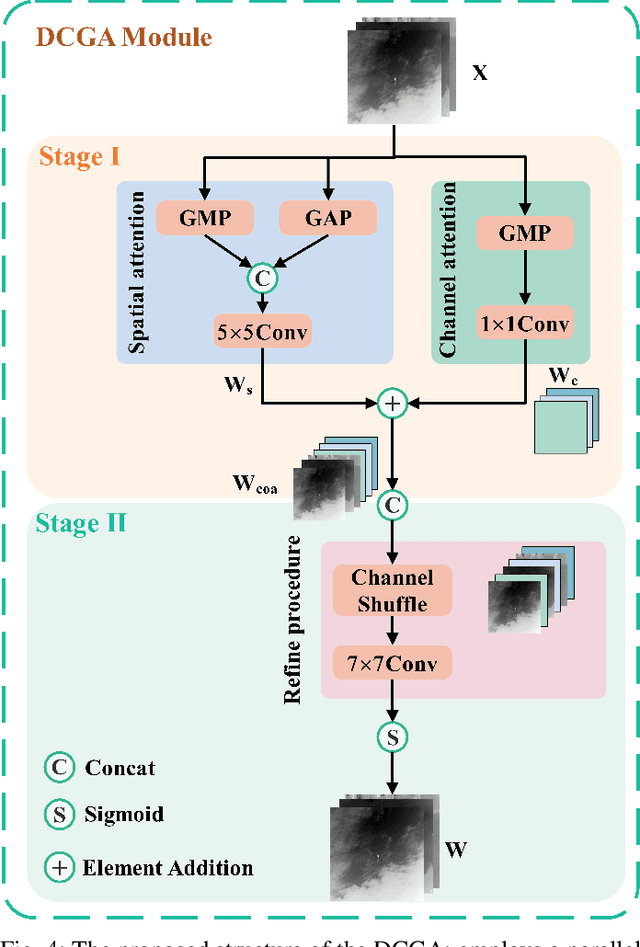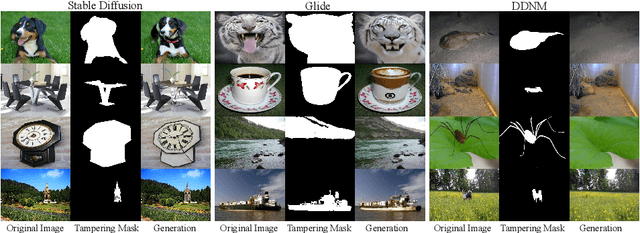Yirui Chen
Selective Variable Convolution Meets Dynamic Content Guided Attention for Infrared Small Target Detection
Apr 30, 2025



Abstract:Infrared Small Target Detection (IRSTD) system aims to identify small targets in complex backgrounds. Due to the convolution operation in Convolutional Neural Networks (CNNs), applying traditional CNNs to IRSTD presents challenges, since the feature extraction of small targets is often insufficient, resulting in the loss of critical features. To address these issues, we propose a dynamic content guided attention multiscale feature aggregation network (DCGANet), which adheres to the attention principle of 'coarse-to-fine' and achieves high detection accuracy. First, we propose a selective variable convolution (SVC) module that integrates the benefits of standard convolution, irregular deformable convolution, and multi-rate dilated convolution. This module is designed to expand the receptive field and enhance non-local features, thereby effectively improving the discrimination of targets from backgrounds. Second, the core component of DCGANet is a two-stage content guided attention module. This module employs two-stage attention mechanism to initially direct the network's focus to salient regions within the feature maps and subsequently determine whether these regions correspond to targets or background interference. By retaining the most significant responses, this mechanism effectively suppresses false alarms. Additionally, we propose adaptive dynamic feature fusion (ADFF) module to substitute for static feature cascading. This dynamic feature fusion strategy enables DCGANet to adaptively integrate contextual features, thereby enhancing its ability to discriminate true targets from false alarms. DCGANet has achieved new benchmarks across multiple datasets.
Efficient 4D Gaussian Stream with Low Rank Adaptation
Feb 23, 2025Abstract:Recent methods have made significant progress in synthesizing novel views with long video sequences. This paper proposes a highly scalable method for dynamic novel view synthesis with continual learning. We leverage the 3D Gaussians to represent the scene and a low-rank adaptation-based deformation model to capture the dynamic scene changes. Our method continuously reconstructs the dynamics with chunks of video frames, reduces the streaming bandwidth by $90\%$ while maintaining high rendering quality comparable to the off-line SOTA methods.
Intelligent Understanding of Large Language Models in Traditional Chinese Medicine Based on Prompt Engineering Framework
Oct 25, 2024

Abstract:This paper explores the application of prompt engineering to enhance the performance of large language models (LLMs) in the domain of Traditional Chinese Medicine (TCM). We propose TCM-Prompt, a framework that integrates various pre-trained language models (PLMs), templates, tokenization, and verbalization methods, allowing researchers to easily construct and fine-tune models for specific TCM-related tasks. We conducted experiments on disease classification, syndrome identification, herbal medicine recommendation, and general NLP tasks, demonstrating the effectiveness and superiority of our approach compared to baseline methods. Our findings suggest that prompt engineering is a promising technique for improving the performance of LLMs in specialized domains like TCM, with potential applications in digitalization, modernization, and personalized medicine.
FASTC: A Fast Attentional Framework for Semantic Traversability Classification Using Point Cloud
Jun 24, 2024Abstract:Producing traversability maps and understanding the surroundings are crucial prerequisites for autonomous navigation. In this paper, we address the problem of traversability assessment using point clouds. We propose a novel pillar feature extraction module that utilizes PointNet to capture features from point clouds organized in vertical volume and a 2D encoder-decoder structure to conduct traversability classification instead of the widely used 3D convolutions. This results in less computational cost while even better performance is achieved at the same time. We then propose a new spatio-temporal attention module to fuse multi-frame information, which can properly handle the varying density problem of LIDAR point clouds, and this makes our module able to assess distant areas more accurately. Comprehensive experimental results on augmented Semantic KITTI and RELLIS-3D datasets show that our method is able to achieve superior performance over existing approaches both quantitatively and quantitatively.
GIM: A Million-scale Benchmark for Generative Image Manipulation Detection and Localization
Jun 24, 2024



Abstract:The extraordinary ability of generative models emerges as a new trend in image editing and generating realistic images, posing a serious threat to the trustworthiness of multimedia data and driving the research of image manipulation detection and location(IMDL). However, the lack of a large-scale data foundation makes IMDL task unattainable. In this paper, a local manipulation pipeline is designed, incorporating the powerful SAM, ChatGPT and generative models. Upon this basis, We propose the GIM dataset, which has the following advantages: 1) Large scale, including over one million pairs of AI-manipulated images and real images. 2) Rich Image Content, encompassing a broad range of image classes 3) Diverse Generative Manipulation, manipulated images with state-of-the-art generators and various manipulation tasks. The aforementioned advantages allow for a more comprehensive evaluation of IMDL methods, extending their applicability to diverse images. We introduce two benchmark settings to evaluate the generalization capability and comprehensive performance of baseline methods. In addition, we propose a novel IMDL framework, termed GIMFormer, which consists of a ShadowTracer, Frequency-Spatial Block (FSB), and a Multi-window Anomalous Modelling (MWAM) Module. Extensive experiments on the GIM demonstrate that GIMFormer surpasses previous state-of-the-art works significantly on two different benchmarks.
 Add to Chrome
Add to Chrome Add to Firefox
Add to Firefox Add to Edge
Add to Edge